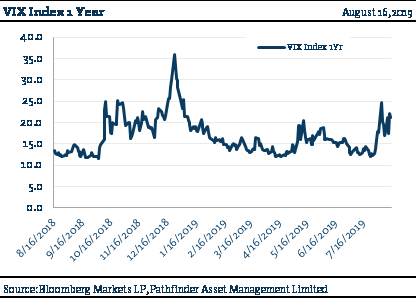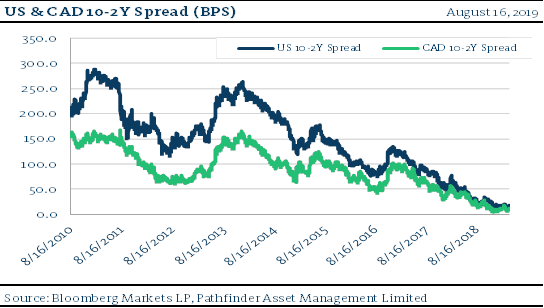Recap & Outlook: The Inverted Yield Curve
To say that the stock markets have been somewhat volatile recently is a bit of an understatement. At the end of last year, stocks in various parts of the world had entered into official “bear markets” as defined by a top to bottom drop of 20%. Some markets then, from the beginning of this year, ramped up into a full bull market bouncing back through 20%. At one point during the rally, volatility as measured by the VIX dropped to a new recent low (Figure 1). More recently with both an attack on the US Federal Open Market Committee (FOMC) Chairman Powell and various machinations of a trade war with China, the US Administration has added significant investor concern, which has resulted in both equity market volatility (as noted above) and fixed income volatility (discussed below).

- Figure 2 presents the recently noted 10-2 US Yield Curve inversion, which is often cited as a strong predictor of recessions. After inverting with a different term structure earlier this year, the market has focused again on this data and grown concerned about the US economy.
- There has also been an inversion in the UK, in addition to contracting economic growth there. Germany and Italy, while not yet in official recessions, have also deteriorated. Along with negative interest rates in some European countries, this has caused investors to grow concerned about the global economy as well.
- Trade wars between China/US & Japan/Korea have caused observable harm to German, Korean and Singaporean economies, which rely heavily on manufacturing and export (i.e. Trade Wars are not “good and easy to win”). These countries are viewed as precursors to the global economy and if they are impacted, markets expect further economic issues to be compounded.

“This means that” we stay the course with our investment strategies. Recently you will have noted that we have been active with trading the portfolios. We view these multiple points of upside and downside volatility as great opportunities to position ourselves to take advantage of (by buying stock and/or raising cash) the fear and greed that so often presents itself during these times.
National Instrument 31-103 requires registered firms to disclose information that a reasonable investor would expect to know, including any material conflicts with the firm or its representatives. Doug Johnson and/or Pathfinder Asset Management Limited are an insider of companies periodically mentioned in this report. Please visit www.paml.ca for full disclosures.
*All returns are time weighted and net of investment management fees. Returns from the Pathfinder Partners’ Fund and Partners’ Real Return Plus Fund are presented based on the masters series of each fund. The Pathfinder Core: Equity Portfolio and The Pathfinder Core: High Income Portfolio are live accounts. These are actual accounts owned by the Pathfinder Chairman (Equity) and client (High Income) which contain no legacy positions, cash flows or other Pathfinder investment mandates or products. Monthly inception dates for each fund and portfolio are as follows: Pathfinder North American: Equity Portfolio (January 2011), Pathfinder North American: High Income Portfolio (October 2012) Pathfinder Partners’ Fund (April 2011), Pathfinder Real Return Plus Fund (April, 2013), Pathfinder International Fund (November 2014) and Pathfinder Resource Fund (May 2018).
Pathfinder Asset Management Limited (PAML) and its affiliates may collectively beneficially own in excess of 10% of one or more classes of the issued and outstanding equity securities mentioned in this newsletter. This publication is intended only to convey information. It is not to be construed as an investment guide or as an offer or solicitation of an offer to buy or sell any of the securities mentioned in it. The author has taken all usual and reasonable precautions to determine that the information contained in this publication has been obtained from sources believed to be reliable and that the procedures used to summarize and analyze such information are based on approved practices and principles in the investment industry. However, the market forces underlying investment value are subject to sudden and dramatic changes and data availability varies from one moment to the next. Consequently, neither the author nor PAML can make any warranty as to the accuracy or completeness of information, analysis or views contained in this publication or their usefulness or suitability in any particular circumstance. You should not undertake any investment or portfolio assessment or other transaction on the basis of this publication, but should first consult your portfolio manager, who can assess all relevant particulars of any proposed investment or transaction. PAML and the author accept no liability of any kind whatsoever or any damages or losses incurred by you as a result of reliance upon or use of this publication.